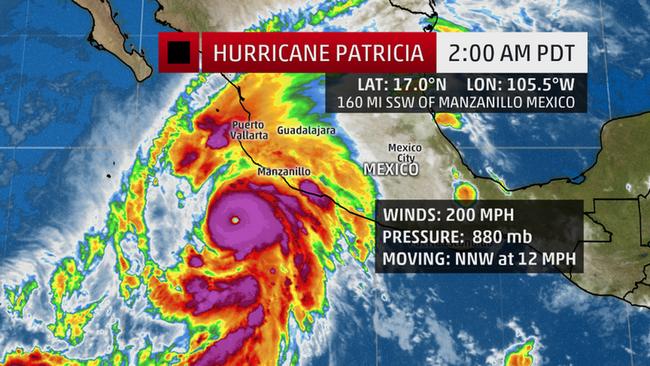The hurricane is forecast to make landfall in the Mexican state of Jalisco Friday evening as a catastrophic Category 5 hurricane capable of causing widespread destruction. Residents and authorities in Mexico are rushing to prepare for what will likely be the strongest hurricane to ever make landfall on that country's Pacific coastline.
At 4 a.m. CDT, the eye of Hurricane Patricia was about 160 miles (255 kilometers) south-southwest of Manzanillo, Mexico, and was moving north-northwest at 12 mph (19 kph).
In addition to its unprecedented 200-mph (320-kph) sustained winds, Hurricane Patricia now holds the record for lowest pressure in any hurricane on record. With a minimum central pressure of 880 millibars (25.99 inches of mercury) at the 4 a.m. CDT advisory, Patricia broke the record of 882 millibars set by Wilma almost exactly 10 years ago.
Data from an Air Force Hurricane Hunter airborne reconnaissance mission late Thursday night provided critical data demonstrating the extreme intensification of Hurricane Patricia in near-real time.
Unprecedented Among Pacific Hurricanes
Hurricane Patricia became the strongest Pacific hurricane on record shortly after midnight CDT early Friday. Air Force Hurricane Hunters had flown through the eye of Patricia and reported a sea-level pressure of 894 millibars as measured by a dropsonde inside the eye itself. Wind measurements suggested that the pressure measurement was not in the exact center of the eye and was probably not the absolute lowest pressure, prompting NHC to estimate the minimum central pressure at 892 millibars in its special 12:30 a.m. CDT advisory.
Tropical cyclone strength comparisons are typically based on minimum central pressure. At 892 millibars, Patricia shattered the Eastern Pacific basin's previous record of 902 millibars set by Hurricane Linda in 1997.
While a number of typhoons in the western North Pacific have been stronger, Patricia is by far the strongest hurricane in any basin where the term "hurricane" applies to tropical cyclones - namely, the central and eastern North Pacific basins and the North Atlantic basin, which includes the North Atlantic Ocean itself plus the Gulf of Mexico and Caribbean Sea.
Exceptionally Dangerous Situation in Mexico
The eye of Patricia is expected to move onshore Friday night in the Mexican state of Jalisco, which includes the popular coastal resort city of Puerto Vallarta as well as the inland metropolis of Guadalajara, Mexico's second-largest city.
The adjoining states of Colima and Nayarit will also feel the effects of Hurricane Patricia, which in addition to catastrophic winds will also bring a formidable flood threat. Depending on the exact track of Patricia's eye, the resort city of Manzanillo may experience destructive winds, and is very likely to see flooding rainfall, dangerous storm surge and large, battering ocean waves breaking onshore.
Watches and warnings remain in effect for parts of Mexico's Pacific coast:
- A hurricane warning includes the Pacific coast of Mexico from San Blas to Punta San Telmo. This warning includes the major coastal resort cities of Puerto Vallarta and Manzanillo.
- A hurricane watch is in effect east of Punta San Telmo to Lazaro Cardenas.
- A tropical storm warning is also in effect from east of Punta San Telmo to Lazaro Cardenas.
Tropical storm conditions are possible early Friday in the warning areas, and hurricane force winds are expected to reach the warning area Friday afternoon or evening.
While the resort area of Ixtapa and Zihuatanejo may see heavy rainfall associated with Patricia, there are no watches or warnings for tropical storm or hurricane conditions there. Acapulco is also not under any watches or warnings for Patricia.
Patricia is forecast to remain a Category 5 hurricane at landfall, making it capable of causing catastrophic wind damage.
Only one Category 5 hurricane has ever been known to make landfall on Mexico's Pacific coast. That hurricane followed a path similar to that of Hurricane Patricia and struck near Puerto Vallarta in late October 1959, causing some 1,800 deaths.
With Patricia less than 24 hours away from landfall, this is the first time a Category 5 hurricane has posed an imminent threat to land in North America since Hurricane Felix approached Nicaragua in September 2007.
Patricia is expected to dump 6 to 12 inches (150 to 300 millimeters) of rain over the Mexican states of Jalisco, Colima, Michoacan and Guerrero. Life-threatening flash flooding and mudslides are possible. Localized amounts as high as 20 inches (500 millimeters) are possible.
A dangerous storm surge is expected to produce significant coastal flooding near and to the right of where the center of Patricia makes landfall. In addition, Mexico's national water comission, CONAGUA, warned Thursday that waves of up to 12 meters (39 feet) may crash onto beaches near the landfall point.
Once this system moves inland, mid-level moisture and energy from it may get pulled into the south-central U.S. This may add more fuel to a heavy rain and flooding threat in Texas and nearby states this weekend.
Impressive Rapid Intensification
Patricia rapidly organized and intensified from Wednesday night through early Friday. Maximum sustained winds with the storm increased 115 mph in a 24-hour window from 85 mph at 4 a.m. CDT Thursday to 200 mph at 4 a.m. CDT Friday.
During that same time, the minimum central pressure of Patricia also decreased 100 millibars, from 980 millibars to 880 millibars.
This places Patricia among the most rapidly intensifying tropical cyclones ever witnessed anywhere in the world since the advent of modern meteorology.




[Link]